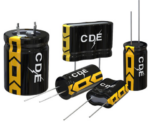The urgency of mitigating climate change and reducing greenhouse gas emissions has prompted businesses to adopt more sustainable transportation solutions, particularly electric vehicles (EVs). Lithium-ion batteries (LIBs) are at the forefront of electrification. McKinsey predicted that the entire LIB chain, from mining through recycling, could grow by over 30% annually from 2022 to 2030, reaching…
EV Engineering
Modeliithics, Knowles to develop RF, mmWave capacitor models
Modelithics welcomes Knowles Precision Devices into the Modelithics Vendor Partner (MVP) Program at the Sponsoring level. Knowles is a leading provider of a wide range of highly engineered capacitors and other components (covering microwave to millimeter-wave frequencies) intended for use in critical applications in military, medical, electric vehicle, industrial, and new energy market segments. Through the Modelithics Vendor…
How do connectors made with conductive plastics contribute to sustainability?
Basic plastics are electrically insulating, but with the proper additives, they can become conductive. Electrically conductive plastics can be used to replace metal components and improve sustainability in several areas of connector construction. They take less energy to fabricate and are lighter, reducing system weight, a very important consideration in applications like electric vehicles (EVs). […]
100 V Trench Schottky diodes boost efficiency in high-frequency power converters
STMicroelectronics has introduced 100V trench Schottky rectifier diodes that boost efficiency in power converters operated at high switching frequencies. Raising power-converter operating frequency, encouraged by the minimal switching losses of technologies like wide-bandgap semiconductors, allows designers to set new benchmarks in power density. However, at elevated frequencies, the energy losses in conventional planar diodes, including […]
What is the best copper alloy for connectors in renewable energy and EV applications?
Copper is important in supporting renewable energy and electric vehicles (EVs). For example, there’s about 5.5 tons of copper used per megawatt (MW) of photovoltaic generation and there’s 183 pounds of copper in an EV, compared with only 48 pounds in an internal combustion engine (IEC) vehicle. Not all copper is the same; there’s a […]
Solving thermal challenges in EV charging
In the ever-evolving landscape of electric vehicle (EV) technology, the pursuit of faster charging speeds and increased efficiency stands as a paramount goal. As significant improvements in EV technology continue in tandem with growing government support, the demand for electric vehicles has never been higher. However, amidst this drive for progress, one critical aspect that […]
Supercapacitors handle 9 WVDC, save board space
Knowles Precision Devices announced its latest Electric Double Layer Capacitor (EDLC), or supercapacitor, modules are now available. Based on Knowles’ Cornell Dubilier brand DGH and DSF Series supercapacitors, these cutting-edge capacitors use a three-cell package for higher operating voltages and printed circuit board space savings. Knowles Corporation acquired Cornell Dubilier in 2023 to expand its offering […]
Gen-2 MOSFET paves way for greener power systems and EV charging
Infineon Technologies AG opens a new chapter in power systems and energy conversion and introduces the next generation of silicon carbide (SiC) MOSFET trench technology. The new Infineon CoolSiC MOSFET 650 V and 1200 V Generation 2 improve MOSFET key performance figures such as stored energies and charges by up to 20 percent compared to […]
How current sensing impacts electric vehicles: part 1
The need to transition from gasoline and diesel (fossil fuels) powered vehicles to electric vehicles (EVs) to reduce carbon dioxide levels has revealed many controversial issues. Common issues include implementation timing, required infrastructure (including fast charging multi-vehicle systems), legislated rather than consumer-based adoption, ongoing system enhancements, and sources of new critical raw materials. One of […]
High-voltage SiC inverter control modules accelerate e-mobility designs and development
At the Applied Power Electronics Conference (APEC), CISSOID released its new series of SiC Inverter Control Modules (ICMs) dedicated to the E-mobility market. These software-powered SiC Inverter Control Modules are designed to help engineers create functionally safe, robust, and modular E-motor drives while dramatically shortening time-to-market. The new CXT-ICM3SA series offers optimal hardware and software […]











